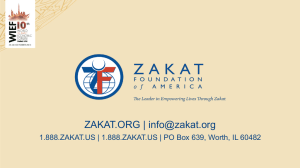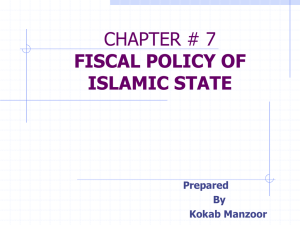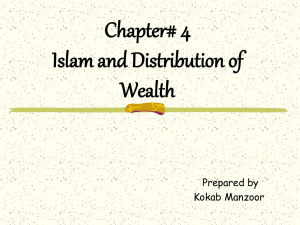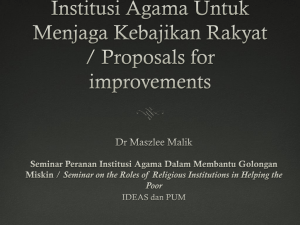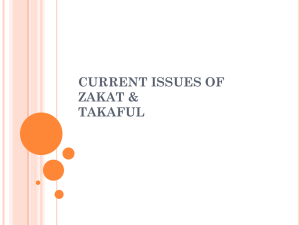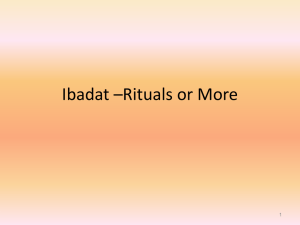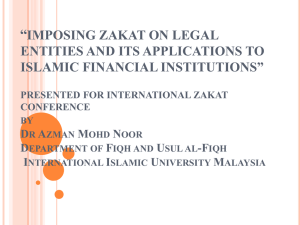ZAKAT VS. TAXATION - Progressive Academic Publishing
advertisement
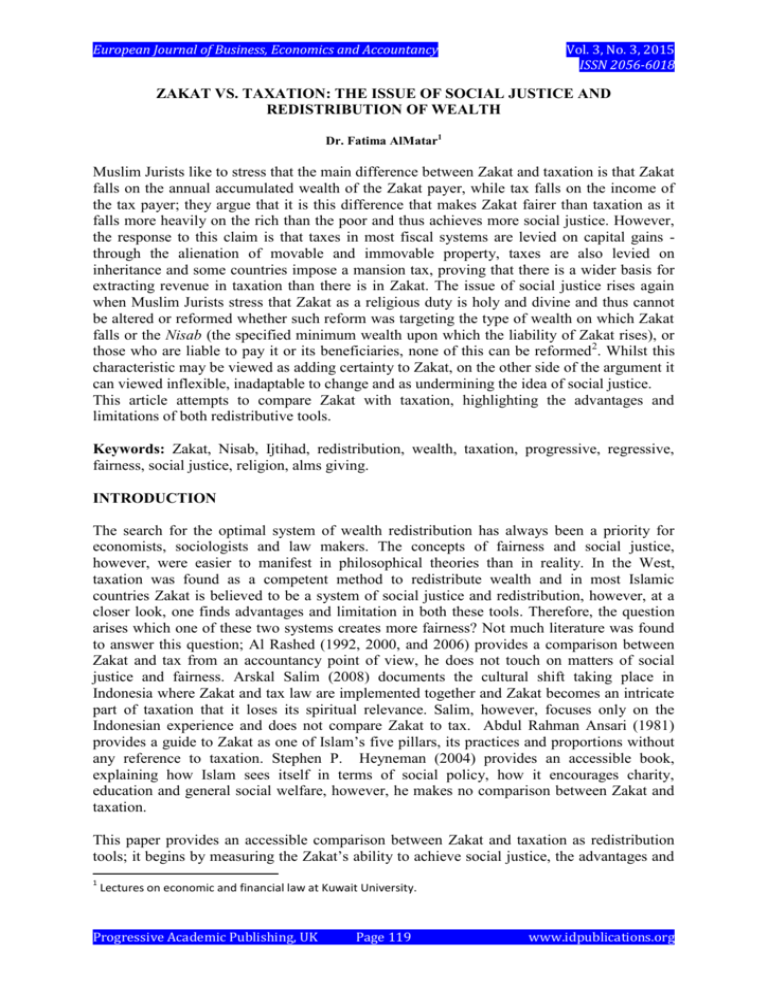
European Journal of Business, Economics and Accountancy Vol. 3, No. 3, 2015 ISSN 2056-6018 ZAKAT VS. TAXATION: THE ISSUE OF SOCIAL JUSTICE AND REDISTRIBUTION OF WEALTH Dr. Fatima AlMatar1 Muslim Jurists like to stress that the main difference between Zakat and taxation is that Zakat falls on the annual accumulated wealth of the Zakat payer, while tax falls on the income of the tax payer; they argue that it is this difference that makes Zakat fairer than taxation as it falls more heavily on the rich than the poor and thus achieves more social justice. However, the response to this claim is that taxes in most fiscal systems are levied on capital gains through the alienation of movable and immovable property, taxes are also levied on inheritance and some countries impose a mansion tax, proving that there is a wider basis for extracting revenue in taxation than there is in Zakat. The issue of social justice rises again when Muslim Jurists stress that Zakat as a religious duty is holy and divine and thus cannot be altered or reformed whether such reform was targeting the type of wealth on which Zakat falls or the Nisab (the specified minimum wealth upon which the liability of Zakat rises), or those who are liable to pay it or its beneficiaries, none of this can be reformed 2. Whilst this characteristic may be viewed as adding certainty to Zakat, on the other side of the argument it can viewed inflexible, inadaptable to change and as undermining the idea of social justice. This article attempts to compare Zakat with taxation, highlighting the advantages and limitations of both redistributive tools. Keywords: Zakat, Nisab, Ijtihad, redistribution, wealth, taxation, progressive, regressive, fairness, social justice, religion, alms giving. INTRODUCTION The search for the optimal system of wealth redistribution has always been a priority for economists, sociologists and law makers. The concepts of fairness and social justice, however, were easier to manifest in philosophical theories than in reality. In the West, taxation was found as a competent method to redistribute wealth and in most Islamic countries Zakat is believed to be a system of social justice and redistribution, however, at a closer look, one finds advantages and limitation in both these tools. Therefore, the question arises which one of these two systems creates more fairness? Not much literature was found to answer this question; Al Rashed (1992, 2000, and 2006) provides a comparison between Zakat and tax from an accountancy point of view, he does not touch on matters of social justice and fairness. Arskal Salim (2008) documents the cultural shift taking place in Indonesia where Zakat and tax law are implemented together and Zakat becomes an intricate part of taxation that it loses its spiritual relevance. Salim, however, focuses only on the Indonesian experience and does not compare Zakat to tax. Abdul Rahman Ansari (1981) provides a guide to Zakat as one of Islam’s five pillars, its practices and proportions without any reference to taxation. Stephen P. Heyneman (2004) provides an accessible book, explaining how Islam sees itself in terms of social policy, how it encourages charity, education and general social welfare, however, he makes no comparison between Zakat and taxation. This paper provides an accessible comparison between Zakat and taxation as redistribution tools; it begins by measuring the Zakat’s ability to achieve social justice, the advantages and 1 Lectures on economic and financial law at Kuwait University. Progressive Academic Publishing, UK Page 119 www.idpublications.org European Journal of Business, Economics and Accountancy Vol. 3, No. 3, 2015 ISSN 2056-6018 limitations of Zakat, the effect of religion upon economic development, and finally, the Western theoretical basis for taxation and the optimal system of tax. Can Zakat achieve social justice? Justice in Islam stands for human equality. Islam does not demand compulsory economic equality in the narrow literal sense of the term. This is against nature and conflicts with an essential fact which is the differing natural endowments of individuals. Enforced economic equality arrests the development of outstanding ability and makes it equal to lesser ability, since different individuals also have different methods by which they earn their livelihood Islam admits the reasonable causes of these differences as being differences in strength and endowment. Hence absolute justice demands that men’s rewards be similarly different and that some obtain more than others so long as human justice is upheld by the provision of equal opportunity for all. Ideally, Zakat could ensure, if implemented carefully that the rich do not become poor but the poor cease to be poor3. From this perspective Zakat makes an obligatory claim on the property of the wealthy in favor of the poor, it is a duty which the government can extract by the authority of the law and by the power of its administration. Siddiqi4 argues that Zakat satisfies the four famous principles of a fair taxation system as set up by Adam Smith5; the four principles are fairness, certainty, simplicity and convenience. Smith considered these four pillars as the back bone to a just system of redistribution of wealth6. In his attempt to sustain his argument that Zakat is an Islamic system of redistribution which parallels with the Western idea of taxation, Siddiqi provides that in regards to fairness, Zakat is levied on the individual’s savings for the period of twelve months, therefore, people with bigger savings will contribute more. As an effect the poorer people of the community will not be prejudiced, as people with no savings are not obliged to pay Zakat. Taxes on the other hand are levied on the income of individuals and increase proportionally as there is an increase in income, leading relatively to more sacrifice being made by the poor than the rich, as no account is taken of the amount of wealth accumulated by the individual. Furthermore it is the poor who benefit more from the revenues of Zakat, which helps to serve one of its main objectives, which is to provide social justice. Siddiqi adds that Zakat provides certainty for the payer, with its fixed rate which equals 2.5% of an individual’s wealth7. He supports this argument by referring to the fact that rate, objective and beneficiaries of Zakat are immutable, unalterable and based on its divine sanction. He adds that in regards to time, amount of payment and forms of expenditure, both for the contributors and the governments, no man made tax can offer more certainty than Zakat does. In terms of convenience, Siddiqi argues that Zakat is also convenient because it is paid annually and by those who are able to pay it, i.e. those with wealth exceeding Nisab, also Zakat offers the convenience of paying it according to its manner of production (i.e. land produce, cattle, articles of trade or in cash). And finally, when it comes to simplicity of calculation, Zakat is a fixed and understandable rate therefore making its collection costs lower than other tax systems. 7 This fixed rate is also called Nisab which is the specified minimum wealth upon which the liability of Zakat rises. Progressive Academic Publishing, UK Page 120 www.idpublications.org European Journal of Business, Economics and Accountancy Vol. 3, No. 3, 2015 ISSN 2056-6018 What are the advantages and limitations of Zakat? Advantages Zakat is a cornerstone of Islam’s social insurance system; it provides relief to those in need and collects funds from those who have access to money. Zakat does not depend on individual voluntary charity, but on a governmental institution that collects regular contributions and distributes organized relief to all those who are in need 8. Zakat also leads to the reduction in income inequality and to an increase in social welfare 9. Abdul Rahman10 argues that Zakat helps increase the purchase power of the poor and thus leads to economic growth in consumption, expenditure and aggregate demand. However, this does not mean that Zakat as a redistributive social system does not have its limitations. Limitation of Zakat 1. Marginalizing non-Muslims: In many Muslim countries today Zakat is no longer obligatory but a voluntary alms giving and the reason behind this is that Zakat is required in the Sunni jurisprudence of Islam but not the Shi’a jurisprudence11, and in most Muslim countries societies are becoming more secular. In Kuwait for example the population is a mixture of 50% Sunni, 40% Shia and 10% of Christians, Jews, Hindus, and Buddhist. Therefore, there is a crucial need to consider the challenges of institutionalizing Zakat. Questions such as who collects and distributes Zakat raise similarly important considerations. The adaptation of Islamic jurisprudence also raises questions related to the appropriateness of new interpretations. The process of finding new interpretations of the Qur’an and Sunna12 is known as Ijtihad , allowing Ijtihad may be viewed as allowing too much freedom in finding new meanings for the verse of the Qur’an and the teachings of Sunna, different than what was initially intended, there is also the fear of interpreting the holy book in ways to serve the interest of some groups and not others, however, closing the door of Ijtihad completely can also be viewed as a disadvantage especially in the case of Zakat. This is highlighted in the second limitation of Zakat below. 2. The scope of Zakat beneficiaries: The Qur’an specifically numbers the beneficiaries of Zakat, the Qur’an in surah “Altawbah”, passage (9:60) provides: “The alms are only for the poor and the needy, and those who collect them, and those whose hearts are to be reconciled, and to free the captives and the debtors. And for the cause of Allah, and for the wayfarer; a duty imposed by Allah” The beneficiaries of Zakat are divided equally into eight groups: the first, are the poor and those who are in material need. The second group is the needy, they are similar to the poor, some scholars have treated the two groups as synonymous, however some scholars have 11 The Shi’a alms are called Khumus (the giving of the fifth of certain goods plus a donation of 20% on income which is then distributed by the Imam on the proxy of Shi’a who he is responsible for. 12 The teachings of the Prophet Mohammed. Progressive Academic Publishing, UK Page 121 www.idpublications.org European Journal of Business, Economics and Accountancy Vol. 3, No. 3, 2015 ISSN 2056-6018 described the poor as more deprived and thus have a priority over the needy. The third category are the people who collect the Zakat, this group is the equivalent of the State’s administrative costs when collecting taxes. The fourth category are those whose hearts are to be reconciled, some scholars say that they are the people who have recently converted to Islam, another interpretation includes those who sympathize with Islam but are not yet believers, this latter interpretation has been used to justify support for missionary activities and potential converts13. The fifth and sixth recipients are captives and debtors, the freeing of captives refers to ransoming prisoners captured in war, and debtors include those who are burdened with debt. The seventh ‘for the cause of Allah’ historically this was used to support those who served as warriors for the defense of Islam. The final category of recipients are the ‘wayfarers’ this justifies expenditure of Zakat money to support travelers 14. It is obvious from the above that Zakat was intended as a redistributive system, however, nowhere in its detailed categories does it mention using Zakat revenues to provide public goods and services. Zakat money (unlike tax money) cannot according to its current interpretation be used to build houses, or fix roads, or provide health and education. Therefore, taxes can be viewed as better a redistributive tool in terms of their spending scope. 3. The progressivity of Zakat: A progressive tax takes a larger percentage from the income of the wealthy than it does from the poor. Tax exemption to the extent of reaching Nisab ensures some degree of progressivity in Zakat as a redistributive tool, this is particularly true if Nisab accurately measures minimal living costs, however, at the upper end of the wealth and income spectrum, there is a drop in progressivity because the rate of Zakat is fixed at 2.5% of the donor’s savings. 4. What system of Zakat to adopt? Some mandatory Zakat systems emphasize the elements of Zakat that function as income tax (Malaysia)15. Others emphasize tax on wealth (Pakistan)16. Others claim to enforce Zakat according to classical jurisprudence (Yemen)17. Each of these options creates different particular advantages and challenges for making Zakat an effective system of poverty alleviation. Emphasis on taxing agricultural production risks putting a disproportionate burden on the poorer segment of society. Emphasis on taxing wealth creates challenges in both estimating and collecting Zakat. In Pakistan deducting Zakat from bank accounts on a fix date caused massive withdrawals to avoid compliance. 5. Allowing donors to choose their beneficiaries: In the absence of alms laws, alms are given on a voluntary and decentralized basis 18. Economic evidence has provided that voluntary giving to local groups or individuals favors certain categories of beneficiaries, for example those who have a relationship with the donor, this pattern of giving does not provide for sufficient redistribution of wealth to alleviate systemic poverty19. Although most Islamic states have established government supported Progressive Academic Publishing, UK Page 122 www.idpublications.org European Journal of Business, Economics and Accountancy Vol. 3, No. 3, 2015 ISSN 2056-6018 entities to receive and distribute voluntary Zakat contributions, donors still prefer to make donations to the people they personally know who are in need of it. The effect of religion upon economic development The modern study of religion and economics begins with Adam Smith’s An Inquiry into the Nature and Causes of the Wealth of Nations (1776). In his book Smith applies his innovative laissez-fair philosophy to several aspects of religion. However, Smith’s fundamental contribution to the modern study of religion was that religious beliefs and activities are rational choices. As in commercial activity, people respond to religious costs and benefits in a predictable observable manner. McCleary20 in her paper Religion and Economic Development provides that showing no preference for one religion over others, but rather permitting any and all religions to be practiced, creates an open market in which religious groups engage in rational discussion about religious beliefs. This setting creates an atmosphere of “good temper and moderation”. Where there is a State monopoly on religion or an oligopoly among religions, one will find zealousness and the imposition of idea on the public; where there is an open market for religion and freedom of speech, one will find moderation and reason. McCleary suggests that the more religious people are, the less economically developed they will be. She defends her theory by providing four primary indicators of the influence of economic development on religion; education, value of time, life expectancy and urbanization. Education; the more educated the person is, the more likely he is to turn to science for explanations of natural phenomena, with religion intended to explain super natural phenomena and psychological phenomena for which there is no rational explanation. According to this view; the higher the level of educational attainment the less religious people will be. When it comes to value of time McCleary argues that economic reasoning tells us that anything that raises the cost of religious activities would reduce these activities. Economic development and participation in the work force raise the value of a person’s time as measured by the value of market wages. Thus, economic development implies a rising opportunity cost of participating in time-intensive activities such as religious services and prayer. Hence people will participate less in religious activities because their time now is more valuable to them. In terms of life expectancy, with people living longer around the globe McCleary argues that participation in certain religions will be low and then rise as the population ages. Finally, Urbanization, in urban areas religion activities competes with other social activities, such as visiting museums, the theatre, concerts and volunteer work, therefore, religious activities will take over an individual’s leisure time and compete with other leisure activities in addition to work. Max Weber (1905) identified the significant role that religion plays in social change; he went as far as to state that the protestant reformation triggered a mental revolution that made possible the advent of modern capitalism. Other scholars prefer to avoid correlating religion directly with economic prosperity; they try to relate it to fundamental institutions that have been shown to be conducive to growth. In his study of development across Italy, Putnam (1993) attributes the prevailing lack of trust toward others in the South to the strong Catholic tradition, which emphasizes the vertical bond with the Church and undermines the horizontal Progressive Academic Publishing, UK Page 123 www.idpublications.org European Journal of Business, Economics and Accountancy Vol. 3, No. 3, 2015 ISSN 2056-6018 bond with fellow citizens. In a cross-country study both La Porta et al. (1997) and Inglehart (1999) find evidence for this theory. On a similar note, Landes (1998) attributes the failure of Spain to develop in the 16th and the 17th century to the culture of intolerance diffused by the Catholic Church, which forced some of the skillful people out of the country. Finally, Stulz and Williamson (2001) attribute the low level of creditors’ protection present in Catholic countries to the anti-usury culture pervasive in the Catholic tradition21 . Unlike Weber, most of these authors provide compelling evidence in favor of their arguments. Guiso, Sapienza and Zingales in their article People’s Opium? Religion and Economic Attitudes suggest that such evidence, however, can be interpreted in two ways. One possible interpretation is that there is something intrinsic to certain religions, such as Catholicism, that makes them inimical to the development of talents and institutions that foster economic growth. An alternative interpretation, which is equally consistent with the results, is that there was something in the past (correlated with religion, but necessarily religion) that trapped a country in a bad equilibrium. According to this interpretation, there is nothing fundamental, but it is hysteria that keeps a country trapped in this equilibrium22. In their paper Religion and Development: Are they Complimentary, Khan and Bashar (2008)23 argue that religion may act as a negative force; possible negative effects of religion on economic growth include religious restrictions on capital accumulation, profit making, credit markets and interests; religion may also increase resource allocation towards church activities. Daniels and Ruhr (2005) used individual survey data of U.S. residents to test the impact of religious affiliation on attitudes towards trade and immigration policies. The results show that in general religious affiliation is a significant determinant of individual international policy preferences. Specifically, members of the three largest U.S. denominations Catholics, Baptists, and Methodists are more likely to favor policies that restrict imports into the United States; it was also found that the views on these issues differ among pre-Vatican II Catholics and post-Vatican II Catholics, and among Baptist and nonBaptist African Americans. The authors hence suggest that religion is an important form of identity and may represent an important source of resistance to a greater economic integration24. On the positive side of religion’s connection to economic development, religion has been found to enhance economic growth and development by promoting a positive attitude toward honesty. Since the concept of ‘truthful living’ is a major emphasis in religious practice, it induces people to bring a sincere attitude in all interactions and dealings. Religion may increase levels of trust and reduce levels of corruption and criminal activity. It may also encourage thrift which would stimulate saving, investment, and therefore economic growth. Religion may also lead to better health levels by discouraging sinful activities as drugs, overeating, gambling, alcohol, etc., for instance alcohol and gambling are strictly forbidden in Islam. The principles of Islamic banking and finance are based on the premise that any kind of financial arrangements leading to investments in such activities are unproductive and socially undesirable and thereby strictly prohibits them. Other supporters of the theory that religion is positively linked to economic development are Dehejia and Dehejia (1993) 25, who have attributed the period of the Mauryan Empire in ancient Indian history (c. 321 - c. 185 BC), also called ‘The Golden Age’, to strong religious faith. The Mauryan Empire witnessed Progressive Academic Publishing, UK Page 124 www.idpublications.org European Journal of Business, Economics and Accountancy Vol. 3, No. 3, 2015 ISSN 2056-6018 the pinnacle of Advaita Vedantic monotheism, the idiom of Hindu thought of the day. The Mauryan Empire became known for its thriving sea and land trade with China and Sumatra to the East, Ceylon to the South and Persia and the Mediterranean to the West, in addition to the silk routes from Europe to China which put India at the center of a vibrant trade route. This economy of the Mauryan Empire was outward looking and confident with a clear parallel between the self-assured and bold religious thought of that day and the economy of the Mauryan Empire where religion relied on and stressed the actions of individuals to generate progress. The authors compare India’s economy during the Mauryan Empire to India’s economy today, where despite impressive infrastructure and technical manpower and despite the phenomenal growth of consumerism in India’s 200 million strong middle class, the country remains largely grounded realizing only a fraction of its growth potential. Religiously India has moved away from the Advaita Vedantic principle ancient India had followed, the decline of Hinduism - the authors argue – seems to parallel the stagnation of the economy26. The above provides the disparities between opinions that link religion to economic development and opinions opposite of that claim. There are also claims that ancient civilizations often ruled their States by mixing religion with law, as did the Islamic civilization when it first emerged. Samson27 points to the fact that until the 18th century, most Islamic countries were ruled according to the framework of the Shari-ah; nevertheless, in the nineteenth century and as an effect of colonization, most Islamic countries were influenced by Western economic theories on taxation. Siddiqi28 argues that the industrial revolution and the emergence of the banking industry had an influence on the Islamic nation and its adaptation of Western theories. He believes that the Islamic nation should abandon Western theories ad adopt Zakat as a mechanism to redistribute wealth. Siddiqi supports his theory by pointing to the constant development and change which Western tax systems have undergone throughout history, whilst the objectives, rates, ad form of the Islamic Zakat has not been changed since it was required of Muslims by the Qur’an. This stability, Siddiqi claims, gives Zakat a great deal of familiarity and certainty. However, in addition to the limitations of Zakat as a system of redistributing wealth, Siddiqi’s claims of stability can be viewed as a disadvantage against Zakat, there is a need to reform fiscal regimes to suit the rapid economic changes occurring worldwide during the outbreak of the current wave of globalization thus it is crucial to have a fiscal system with the flexibility to develop and the resilience to adapt to change. As the above discussion hints on the convenience of taxation in a highly globalized world, there is a need to look at the theoretical foundation for levying taxes and the different theories on what constitutes an optimal taxation system. Western theoretical foundation for taxation There are many Western theorists such as Hobbes29, Locke30, Rousseau31, Smith32, Murphy and Nagel33, and others who have endorsed taxation as a means of financing governments Progressive Academic Publishing, UK Page 125 www.idpublications.org European Journal of Business, Economics and Accountancy Vol. 3, No. 3, 2015 ISSN 2056-6018 and redistributing wealth. These theorists shared a concern over poverty and excessive unequal distribution of wealth and income and sought taxation as a means of relieving the disparities between the wealthy and the less advantaged34. In his theory of the social contract, Jean-Jacques Rousseau argues that tax levying is based on a contractual relationship between the state and the individual whereby taxes are paid in exchange for services provided by the state, such as security and other public services. According to Adam Smith, the contract is a rental one whereby the state provides individuals with services and they pay rents for them. Smith’s argument is that taxation comes with government, and that people must agree to give up a little of their property in order to maintain government; what governments do aside from protecting people is important enough to justify taxation. Smith suggests that people have a reasonable expectation that they will be taxed. Hobbes on the other hand argues that it is an insurance contract where tax is a premium paid by the individual to ensure the protection of the rest of his wealth. Murphy and Nagel in ‘The Myth of Ownership’ reject the idea that people’s pre-tax income and wealth are theirs in any morally meaningful sense. Property rights are the rights people have in the resources they are entitled to control after taxes, not before. While Locke makes property a personal right and regards the protection of personal rights as the central task for which governments are established, Locke finds no alternative to taxation to maintain government and redistribute wealth. Western theories on what constitutes an optimal system of redistribution Hobbes proposed that tax be imposed according to the benefit derived by each individual from the existence of the state and from the services it provides. The ensuing centuries saw scholars debate the structure of such a tax and, in particular, whether the “benefit principle” could be used to justify redistribution of wealth. Some scholars argue that since the wealthy obtain more benefit from the protections afforded by the state, they should be subject to a higher tax burden. Adam Smith focused on the protection of property and argued for a proportional tax on income: “the subjects of every state ought to contribute towards the support of the government, as nearly as possible, in proportion to their respective abilities; that is, in proportion to the revenue which they respectively enjoy under the protection of the state. John Stuart Mill suggested that in order to promote the utilitarian ideal of “the greatest happiness for the greatest number” taxes should impose the least aggregate sacrifice on society by imposing equal sacrifice on tax payers35. Those supporting Mill’s theory provide that if sacrifice is negative happiness, then minimizing aggregate sacrifice will necessarily maximize the aggregate happiness 36. Optimal tax theorists want a tax base that is inelastic; favoring utilitarianism over equity. This school goes back to the sacrifice theory; they argue that all tax payers should suffer an equal sacrifice while also saying that the least sacrifice should be occasion to the whole 37. In more recent times, the search for the ultimate principle of taxation seems to have abated. Commentators routinely claim that taxation seeks to achieve a multiplicity of goals. These goals include applying public goods, redistributing wealth, encouraging beneficial behavior, discouraging behavior considered detrimental to society and so forth. Tax structures and individual tax provisions are evaluated by their ability to contribute to the realization of these Progressive Academic Publishing, UK Page 126 www.idpublications.org European Journal of Business, Economics and Accountancy Vol. 3, No. 3, 2015 ISSN 2056-6018 goals. Richard Musgrave38 believed that the most important role of taxation was to provide the means for adjusting the distribution of income. This was based on the firm belief that a free private market system, while contributing to the achievements of efficiency and growth, should necessarily result in an acceptable distribution of income that is important for the quality of life and social stability. His interest was to find a system of taxation which would be understandable and acceptable to the electorate as he considered most optimal tax policies marred by questionable assumptions made and the fact that equity implications were less than transparent, moreover he saw that these models often conflict thus raising questions about their applicability. There are two dimensions to Musgrave’s concept of tax equity; the choice of an appropriate tax base and the rate structure which it applies. Musgrave believed in a broad tax base founded on the concept of the ability to pay. As in recent years public finance economists have turned away from income to consumption as a tax base, Musgrave, although acknowledging the advantages of a consumption tax, stuck to his belief that income should be the preferred base39. CONCLUSION Zakat helps reduce income inequality by narrowing the gap between the rich and the poor and it increases the purchasing power of the poor. The Qur’an and Sunna provide: ‘The alms are only for the poor and the needy..’ (the Qur’an, surah 9:60), this has also proven to be restricting in terms of beneficiaries, and its marginalizing of non-Muslims. Also the fact that Zakat is voluntary in Kuwait means there’s a high rate of non-compliance; Zakat also allows the donators to choose their beneficiaries, leading many Zakat payers to give to relatives or acquaintances who they might think are in need, which can completely undermine the objective of allocating the funds to the individual and communities who are more entitled to it. Closing the door to Ijtihad has disallowed innovation in Zakat whether in broadening the scope of its tax base, or reforming its beneficiaries. All the above can confirm that Zakat cannot - in its current form – become the sole welfare system that can finance government expenditure. But does this necessarily mean that taxation can provide more social justice in areas where Zakat did not? Or to put it differently, can taxation play a more efficient role in redistribution where Zakat was found limiting i.e. in redistribution and financing the government in its provision of public goods and services? Western theories which argue in favor of the foundation of taxation are convincing, one of such theories is Adam Smith’s argument that as individuals we must contribute (in proportion to our abilities) towards the state in proportion to the revenue we as individuals could not have enjoyed or earned if it weren’t for the protection of the state, whereby the state provides us with services and we in return pay for them, is a plausible one, especially if we as people took into account that without roads and infrastructure we cannot practice our professions, and without health services we would not be healthy enough to work or have healthy employees, clients or consumers. Also without the security services and justice system the state provides we would not feel safe and would not be able to secure what flows from our work and efforts. However, the implementation of taxation is not as straight forward as the theory. When it comes to measuring the proportion which individuals are capable of contributing towards the state and whether this contribution should differ according to individual capability, taxation becomes more problematic in achieving social justice. Therefore, taxation maybe a successful tool for Progressive Academic Publishing, UK Page 127 www.idpublications.org European Journal of Business, Economics and Accountancy Vol. 3, No. 3, 2015 ISSN 2056-6018 redistribution and financing the government’s provision of public goods and services, however, finding a just system of taxation is not a straight forward process. REFERENCES 2. Qardawi, Y., (1999), “Fiqh Az-Zakat: A Comparative Study”, Dar Al Taqwa, pp. 550-551. 3. Benthall, J., (1999), “Financial Worship: The Quranic Injunction to Almsgiving”, The Journal of Royal Anthropological Institute, PP. 27-42. 4. Siddiqi, S. A., (1992), “Public Finance in Islam”, (2nd edition) Adam Publishers and Distributors, India, p. 113. 5. Smith, A., (1776), “An Inquiry into the Nature and Causes of the Wealth of Nations”, Clarendon Press 1976, Oxford, p. 1152. 6. Smith, A., (1776), Oxford. 8. Benthal, J., (1999), The Journal of Royal Anthropological Institute. 9. Jehle, G. A. (1994), “Zakat and Inequality: Some Evidence from Pakistan”, Review of Income and Wealth, Series 40, Number 2, pp. 205-216. 10. Abdul Rahman, A., (2002), “Zakat Accounting: Creating Business Wealth”, Akauntan Nasional, pp. 11-6. 13. Kassis, E. H., (1983), “A Concordance of the Qur’an”, University of California Press, p. 431. 14. AlGhazali, A. H., (1975), “The Mysteries of Alms Giving”, Books Concern, Translated by Nabin Faris, pp. 5-11. 15. Bin Mohammed, A., (1993), “Zakat and Rural Development in Malaysia”, Berita Publishing: Kuala Lumpur, pp. 185-186. 16. Mayer, A. E., (1986), “Islamization and Taxation in Pakistan” in “Islamic Reassertion in Pakistan”, Syracuse: Syracuse University Press, p. 68. 17. Fallon, G. M., (1993), “The Taxation of Companies and Individuals in Yemen”, Arab Law Quarterly, pp. 37-41. 18. Hassan, R., (2005), “Giving and Gaining: Philanthropy and Social Justice in Muslim Societies”, Paper presented at a workshop at Flinder University, Nov. 2005. 19. Prihatna, A. A., (2005), “Muslim Philanthropy: Potential and Reality of Zakat in Indonesia: Survey Results in Ten Cities”, Kota Depok: Pirmedia, pp. 67-70. 20. McCleary, R., (2008), “Religion and Economic Development”, Policy Review, p. 148. 21. Guiso, L. et al, (2002), “People’s Opium? Religion and Economic Attitude”, Journal of Monetary Economics, 50 (2003), pp. 225-282. 22. Guiso, L. et al, (2002). 23. Khan, H. and Bashar, O. (2008), “Religion and Development are they Complimentary?” U21 Global Working Paper, p. 5. 24. Khan and Bashar (2008). 25. Dehejia, R. and Dahejia, V. (1993), “Religion and Economic Activity in India: A Historical Perspective”, American Journal of Economics and Sociology, Vol. 52, Issue 2, pp. 145-153. 26. Dehejia and Dehejia (1993). 27. Samson, W. (2002), “History of Taxation (cited in) Lymer, A. ad Hasseldine, J. (eds), “The International Taxation System”, Kluwer Academic Publishers, Boston, pp. 21-41. 28. Siddiqi (1992). 29. Hobbes, T. (1651), “Leviathan”, Cambridge University Press, p. 238. 30. Locke, J. (1824), “Two Treaties of Government”, London, p. 220. 31. Rousseau, J. J. (1762), “The Social Contract”, Wordsworth edition, 1998, p. 115. 32. Smith (1776). Progressive Academic Publishing, UK Page 128 www.idpublications.org European Journal of Business, Economics and Accountancy Vol. 3, No. 3, 2015 ISSN 2056-6018 33. Murphy, L. and Nagel, T. (2002), “The Myth of Ownership, Taxes and Justice”, Oxford, p. 108. 34. Bradley, M. (2010), “The Invisible Handout, Smith, J.S. Mill and Marshall on Inequality and Progress”, University of Maryland, p. 1. 35. Mill, J. S. (1848), “Principles of Political Economy”, The Great Mind Series, p. 805. 36. Elkins, D. (2009), “Taxation and the terms of Justice”, University of Toledo Law Review”, Vol. 41, pp. 73-75. 37. Tiley, J. (2008), “Revenue Law”, Hart Publishing, p. 14. 38. Musgrave, R. A. (1958), “The Theory of Public Finance”, New York: McGraw-Hill, p. 312. 39. Head, J. and Krever, R. (2009), “Tax Reform in the 21st Century”, Kluwer, p. 8. Progressive Academic Publishing, UK Page 129 www.idpublications.org
